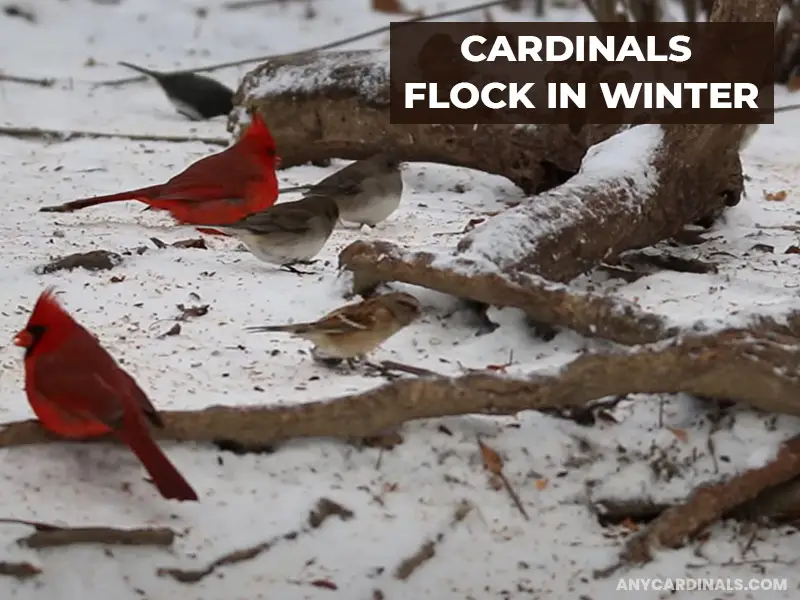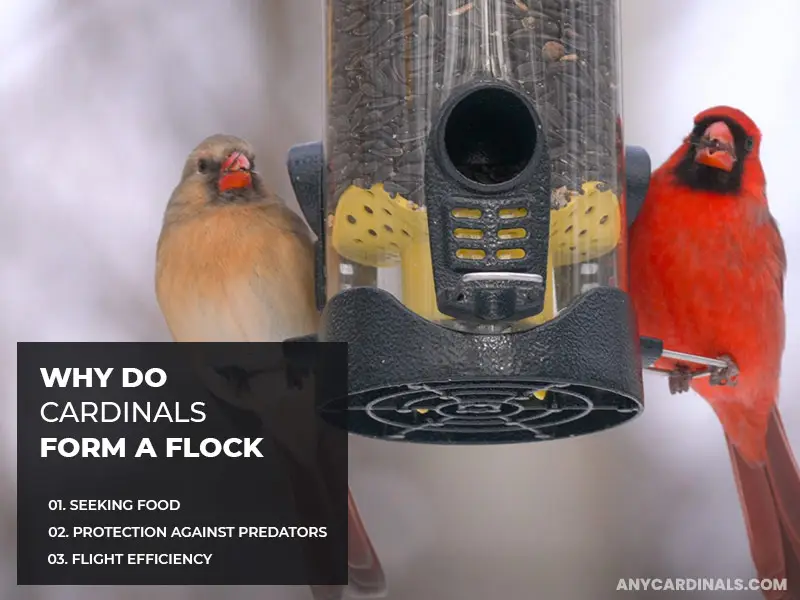Do Cardinals Flock Together? Truths About Their Group Behavior
Numerous birders have witnessed cardinals pairing with mates, flying in pairs, and living with the family. But very few have spotted cardinals in other bird groups.
So, does that mean they are antisocial? Don’t they prefer other birds’ presence and perform activities like flocking? What do you think? Do cardinals flock together?
FYI, cardinals are moderately social and spend most of their time with their mates and chicks each year. But they get along with other cardinals and form a flock while foraging for food.
Hence, if you wanna know when they flock together and other related information about cardinals’ flocking, let’s read this blog post thoroughly.
Do Cardinals Flock Together In Winter?
Yes, cardinals flock together in winter. They spend hours on cold days foraging for food and feeding together.

But their flock is temporary; as the winter fades away, cardinals’ hormones make them set apart from the flock and search for a territory where they can make a great bond with their mates and form a family.
A fascinating fact about the cardinal is that these birdies will consider other cardinals and birds as intruders with whom they had flown together as a flock right after setting up a new family; quite gross.
These winter flocks, often 5-20 birds, disband by early spring as territorial behavior intensifies for breeding, per National Geographic.
For a closer look at mating, nesting, and territorial habits, cardinal behavior tells the full story.
Why Do Cardinals Form a Flock?
For various reasons, Cardinals form a flock, especially during the winter. Below, we have briefly discussed those causes to help you comprehend cardinals’ flock-forming behavior.
01. Seeking Food
Researchers have found that cardinals form a flock while searching for food in the winter. They think cardinals believe that they can easily find food while foraging for food in a group instead of searching for meals alone.

However, it’s a fact that they succeed in finding food while traveling in a flock, but cardinals barely find any meal while flying in a pair or alone during the winter.
Flocking increases foraging efficiency by allowing them to cover larger areas and share food source information, reducing starvation risk.
02. Protection Against Predators
It becomes difficult for predators like hawks and falcons to hunt cardinals when cardinals are flying in a group because numerous cardinals can keep an eye on predators and alarm the flock members when sensing any danger.
So, this is one of the causes why cardinals form a flock and wander from point A to B in search of food during the fall.
This “many-eyes” strategy enhances vigilance, with flock members using sharp chirps to warn of approaching threats, per eBird.
03. Flight Efficiency
Flight efficiency is another reason for cardinals to form a flock. It’s proven that birds spend less energy flying in a group than in pairs or alone.
FYI, migratory birds fly in a group, applying various formations to conserve energy and reduce wind resistance. Cardinals also do the same to save energy but without compromising the flying speed on those cold days.
Unlike migratory birds, cardinals use loose, non-formation flocks to conserve energy while staying close to food-rich habitats.
Frequently Asked Questions
01. What Is A Flock Of Cardinals Called?
Various people recognize a flock of cardinals with different names, such as a college, a conclave, deeck, the Vatican of cardinals, radiance, etc.
These names reflect their vibrant red plumage and group behavior, often seen as symbolic in cultural contexts.
02. Do Male Cardinals Flock Together?
Yes, male cardinals flock together. Essentially, they enter a group of cardinals while foraging for food in the winter. That flock consists of both male and female cardinals.
Males may dominate flock interactions, establishing hierarchies through subtle displays of aggression.
03. Do Female Cardinals Flock Together?
In a cardinal flock, you can witness both male and female cardinals. Both male and female cardinals take long flights seeking food during the fall. So, we can conclude female cardinals flock together.
Females often join mixed-sex flocks, benefiting equally from group foraging and predator protection.
04. Do Cardinals Travel In Groups?
Usually, cardinals don’t travel in groups, but they form in a flock consisting of five or more pairs of cardinals in the winter. The flock can get as large as seventy birds during the fall.
Larger flocks are more common in areas with abundant food sources, like suburban feeders.
05. Do Cardinals Fly In Pairs?
Indeed, cardinals fly in pairs during the mating session. They also travel in flocks with other cardinals in the wintertime in search of food. This flock may or may not contain cardinals’ mates.
Pair-flying during mating season strengthens bonds, while winter flocks prioritize survival over pair dynamics.
06. What Does It Mean When You See A Flock Of Cardinals?
It simply means cardinals are foraging for food to overcome food scarcity during the fall. However, many birders believe a flock of cardinals represents a happy sign telling their lost ones will live forever in their memories.
This cultural belief stems from their striking red color, often associated with hope and remembrance.
Tips for Observing Red Cardinal Flocking Behaviors
Best Times: Watch in winter (December-February) to see flocks at feeders or in open fields.
Binoculars: Use binoculars to observe flock dynamics without disturbing them.
Feeders: Stock feeders with sunflower seeds to attract flocks for closer observation.
Location: Focus on areas with dense shrubs or berry-rich trees where flocks gather.
Conclusion:
Although cardinals don’t tolerate other cardinals or birds around their territories during the mating season, when the winter begins, they get along with other cardinals, forming a flock to forage for food during the food scarcity. Hence, it’s evident that they unite to surpass difficult times successfully and thrive.
That’s all for the content. We hope you learned something new today about cardinals and enjoyed reading this article. However, you may stay connected with us on Twitter & Pinterest for updates on more exciting content.
Image Credits:
- YouTube.com (BHD812)
- Canva.com/photos

